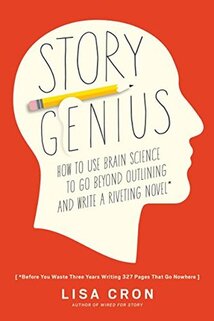|
“This might be a good time to remember that writing a novel is hard.” Overall, Story Genius was a wonderful read with a refreshing take on the writing process. If you open up this book with even a glimmer of an idea for a novel, if you follow along, you can close the back cover well into the first chunk of your first draft. But if you’re a little farther along in your writing process, the concrete method outlined in this book won’t necessarily work for you exactly, and some pieces may be redundant or irrelevant. Regardless, there are some incredible ideas in this book about the craft and philosophy of writing that everyone can learn from. I’ve outlined some of the major points below.
1. Story and plot are not the same thing. One of the earliest and most important assertions that the author makes is this, and if you take away nothing else from her work, this should be the thing. Without a story behind it, a plot is nothing but a string of external events with no significance, and because of this, a plot on its own does not have the power to grasp readers. A story, on the other hand, is about a specific, difficult obstacle that a character faces and how that character is forced to change their worldview and deal with a specific internal conflict as a result of those events. This distinction is extremely important, and the reason goes back to the psychological reason why stories are so compelling to us as humans. A well written story leaves us so in-tune with the struggles and emotions of the protagonist that we are not merely sitting there watching as the events of the fictional world unfold, but we are living those events in full color through the character’s eyes, a phenomenon that occurs in no other medium of modern entertainment. And in striving to achieve that phenomenon, we must give our readers the juicy, emotional bits of internal conflict that allow us to experience a book as more than just a series of events playing across a scene. 2. A novel must be written in chronological order. One of the main traps that beginning writers fall into is the temptation to jump around when they’re writing from scene to scene, writing when the inspiration strikes and you get into the right mood. Now, it’s very likely that you’re thinking that this sounds ridiculous, pretentious, and arbitrary, and initially, you might be right. But upon closer inspection, this rule actually makes a lot of sense. Internal logic is essential to the success of a novel, and it must be based off of a coherent, concrete cause-and-effect trajectory. Simply put, each event (and each internal change that accompanies it) needs to have been cause by the event before it and needs to trigger the one after. Without this, your novel will be left feeling episodic, one event that happens after another, after another, but never escalating into one, distinct, climactic conflict. This interior logic will also allow your reader to try to guess what will happen next, and instead of making your book predictable, it will actually make your novel more fun to read. There is one exception too this rule, however, and it comes in the form of the ending scene. Over the course of writing your novel, it helps to have a clear destination in mind so you can make sure your plot doesn’t veer way off track. 3. Your protagonist must begin the story with a specific past. Think about it. We already know that it is essential for a successful story that your protagonist must undergo an internal change. And in order to change, you have to have a starting point that you can change from. It sounds glaringly obvious, so it’s surprising how many authors overlook this detail and fail to learn anything about their main character that happens before page one. It’s incredibly important to establish your character’s starting worldview because this internal set of beliefs will bleed their way onto the page by informing every decision that this character will make. But it’s not enough to decide on a general belief system. It’s important to delve into the specific events and circumstances that shaped your character’s worldview before the book even begins, as well as the specific ways the character reacted and was affected by them. You’d be surprised to find out how often fleshing out these early scenes early on will help when it comes time to writing your manuscript because its very likely that they’ll make it onto the page in some form, likely as flashbacks or backstory. 4. A finished novel is many layers deep, but it is important to remember that they don’t begin that way. Looking at the intricate weave of subplot upon subplot, dozens of secondary characters, exhilarating settings, internal struggle, and external hurtles, writing a novel can be extremely intimidating, and it can also lead to the misconception that novels are written this way, with all of these layers being seamlessly developed side by side, all at once. But that simply isn’t the case. A complex novel is formulated one layer at a time, so don’t let that initial fear convince you that it’s better to take the simple route and only write one layer at all, because subplots are what keep a novel interesting and distinguish it from others in its genre. Instead, as you trek along with your main story-line, notice the obvious subplots that start to evolve. As you learn more about your characters and your plot, you can start to write in the interesting details that make up a secondary story-line. The trick is, after you discover these lines, to double back to the early stages of your manuscript and make it look like you knew what you were doing all along. So yes, writing a novel is hard. But with the wonderful insight and compelling tone that Lisa Cron provides in Story Genius, the process gets just a little bit easier. Buy it on Bookshop Author Website
1 Comment
Fran Spence
3/8/2019 07:27:55 am
Great blog, Layla!
Reply
Leave a Reply. |
CATEGORIES
All
Currently Reading:
Native Tongue by Suzette Haden Elgin From the Author:
Looking for something I've reviewed?
Visit my Bookshop to help support independent book stores! |

 RSS Feed
RSS Feed

